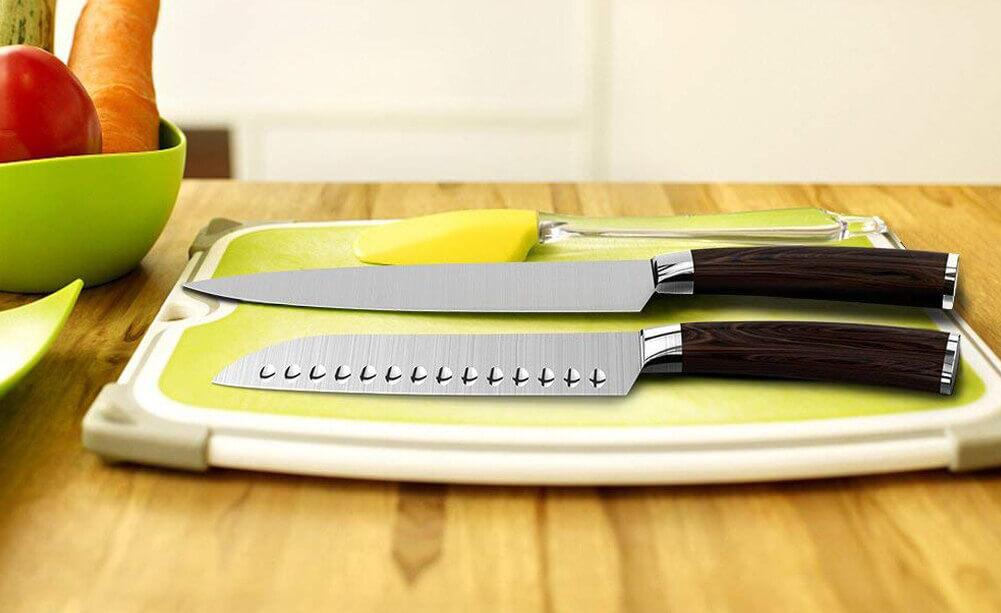In the field of kitchen knives, what Japanese and German kitchen knives to the field of kitchen knives are like iPhones to the field of mobile phones.
It is a "high-quality" product that has been recognized by countless public praise. Many people who pay attention to the quality of life choose these two as their first choice when choosing kitchen knives, it’s better to figure out difference before you buy them.

Let's compare their advantages in terms of material, blade angel, blade design, price. After reading, you may know who is more suitable for you.
1. Materials
Those who have a little knowledge of kitchen knives know that Japanese knives are famous for their unique sharpness. In comparison, German knives are more durable but slightly less sharp, which has a lot to do with their material hardness.
The hardness of stainless steel is assessed by Rockwell hardness C scale (HRC), the higher the value is, the greater the hardness is. German kitchen knives such as Zwilling, WMF, etc. mostly use 1.4116 or X50CRMOV15, and the hardness value is between 54-57; while the VG-10 hardness value commonly used in Japanese kitchen knives is 60+, higher-end(expensesive) choice are Tamahaganei steel and powder steel the HRC can be up to 62.
1.1 Materials of German kitchen knife
German knives are mostly low-carbon stainless steel, represented by X50CrMoV15, which is the mainstream material of German kitchen knives. Shuangliren, WMF, Sancha and other well-known German brands mostly use this material.
Advantages of German kitchen knife materials: Low hardness and easy processing, which is also one of the reasons why the German knife process is more perfect. In addition, the low hardness leads tobetter toughness, it is not easy to rust, and it is better to maintain and maintain.
Disadvantages of German kitchen knife: he hardness is low, so the sharpness is slightly inferior to Japanese kitchen knives, and the sharpness retention is poor and it is easier to be blunt.
1.2 Materials of Japanese kitchen knife
There are mainly two types: high carbon stainless steel mainly represented by VG-10 and carbon steel represented by Tamahaganei steel and powder steel.
- High carbon stainless steel
High carbon stainless steel(such as VG-10):refers to the high-end stainless steel produced by Japan's Takeo Special Steel Co., the carbon content (determining hardness) is up to 1/1000 and the hardness is up to 60+.
Advantages of high carbon stainless steel: Sharpness, retention and durability are all relatively balanced.
Disadvantages of high carbon stainless steel:High hardness leads to poor toughness, easy to crack due to improper use.
However, on the market, the outer layer of VG-10 knives are stainless steel mild steel, in the middle is vg-10, so as to avoid disadvantages.
- Carbon steel
Carbon steel represented by Tamahaganei steel and powder steel. Tamahaganei steel is the purest carbon steel in Japan.
- Tamahaganei steel
The production standards of Tamahaganei Steel are unified, and the alloying is strictly in accordance with No. 1, No. 2 and No. 3, which can be divided into: white paper, green paper, silver paper and yellow paper. Yellow paper has been eliminated now.
Advantages of Tamahaganei steel: High hardness (some even higher than VG-10), high sharpness, good sandability, good rigidity and good retention.
Disadvantages of Tamahaganei steel:Easy to rust, the requirements for use and maintenance are relatively high.
Apply: Professional chefs, mostly used in Japanese food stores.
- Powder steel
Powder steel is a general term for all steel products made with powder metallurgy technology. The production standards are not uniform,so the carbon content varies too.
Advantages of powder steel:
- It contains large alloy content, you can add a large amount of carbon, tungsten, vanadium and other elements, so the production hardness can reach 60.
- The crystal grains are delicate, and the blade can be ground to a very delicate shape without crystal flaking.
- The particles are evenly distributed, and vanadium alloys can be added to improve retention,not easy toblunt.
Disadvantages of powder steel: Expensive is the biggest disadvantage, SG2 · 60 is twice as expensive as VG-10.
In general, Japanese knives are sharp and not easy to be blunt, but have higher requirements for users. German knives, the toughness of the knives is relatively better, not easy to damage and more durable, easy to maintain and polish. However, the sharpness will decrease, the blade retention will be slightly worse, it requires more frequently sharpen.
2. Blade Angle
In addition to the hardness of the material, the blade angle also affects the sharpness of a knife. The blade angle of the German knife is generally 20-22 °; the Japanese knife is harder, so the blade is very small and will not curl, and the blade angle is smaller, between 10-16.

The Japanese believe that the smaller the blade angle is, the smaller the cutting path of the knife is and the less damage to the food. Especially when dealing with sashimi, it can reduce the damage to the cell wall and maintain the original taste to the greatest extent. The section is smooth like a mirror and the tongue feels smooth.
Generally, both Chinese and Western knives have double-edged edges, while Japanese-style knives have single-sided edges:

The main advantages of single-sided cutting are that it is easier to perform ultra-thin cutting and reduce the amount of food adhesion. This fully embodies the Japanese people's ultimate pursuit of fine cutting. Single-edged knives are generally more common in five-star hotels with very high cutting accuracy requirements. Masters with good knife skills can use it to cut radishes into a whole sheet like a scroll.
However, single-edged knives are not friendly for left-handers, so double-edged knives are more common on the market.
3. Blade Design
The design of both knives is influenced by their culture. Japanese people love sashimi and value the taste and appearance of food. They have higher requirements for knives. Different ingredients requires different knives, and the blade body is also lighter and thinner which make iteasy to be controlled.

The Germans pay more attention to the versatility and durability of knives, so the blades are designed to be thicker and heavier to meet the needs of soft, hard and heavy ones. Japanese knives of the same size are half lighter than German knives.

In this regard, German knives and Chinese knives are more similar, so they are very easy to use. People who use Japanese knives for the first time may not like it being too light, but after using it a few times, you will fall into the thrill of sharp cutting.
In a nut shell, Japanese knives are better at fine cutting, it can easily cut meat slices as thin as paper and cut vegetables into hair strands,and cut bread without chipping ... Handling fluffy ingredients such as meat, fish, and vegetables, nothing is more perfect than a Japanese knife. But cutting heavy and hard things is a bit challenging, such as cutting bones and even damaging the knife.

The German knife is more like a rough old man. It can do both thick and thin work, such as cutting, chopping, chopping, and shaving.
Another point is that many Japanese knives are handmade by craftsman, and some old knives brand company are not keen to expand reproduction. It insis that each knife is forged by a professional craftsman, the sharpness of the blade can also have a good durity at the same time.

There is no such inheritance for German knives. Basically, they are mass-produced in factories. Of course, their craftsmanship has reached the high requirements.
4. Price
Like cars and cameras, most of the top products in the world of kitchen knives come from Germany and Japan.In terms of price, German knives and Japanese knives have entry knives and high-end knives, ranging from $60 to $1200.In most cases, the price of Japanese kitchen knives is much cheaper than the same level of German kitchen knives.
Today, we recommend this Japanese knives for you:
Buy it from: https://www.letcase.com/products/japanese-vg10-67-layer-damascus-kitchen-knives
The material is VG-10, the blade angel is, it has a nice-looking surface and it attached with a elegant and mysterious black pakage, as a gift for yourself or your people you care, this damascus chef’s knife is a good choice. I hope you’ll like it.



0 comments